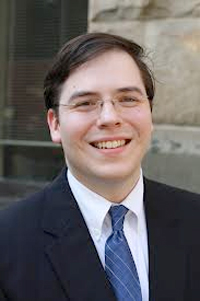by Timothy Robson

Starting the program with J.S. Bach’s Prelude and Fugue in e, BWV 548 (“Wedge”) was a daring move, with its complex counterpoint and considerable technical demands. Feddeck articulated the prelude cleanly, perhaps even a bit too much so for the relatively dry acoustic of Gartner Auditorium. The fugue (nicknamed “wedge” for the outward pitch movement of its subject) was given a chamber music approach. Often played on a full registration, Feddeck opted for a lighter approach to begin, building the dynamics during the course of the fugue.
Turning to the music of Bach’s slightly older French contemporary, François Couperin, Feddeck chose two movements from the Mass pour les Couvents. The two segments were performed out of the order in which they would appear in the Mass itself, but in concert, his order made more musical sense.
Couperin’s French Baroque style favors highly colorful registrations specified by the composer in the titles of the movements. These titles are a sort of shorthand meaningful to organists, but not necessarily to audiences. Feddeck began with the Elévation tierce en taille, a piece to be played during the segment of the Mass in which the bread and wine of the Eucharist become the body and blood of Christ. The sound is one in which harmonics (the nasard and tierce) are combined to create a peculiarly rich sound. The chant is played in a highly ornamented form in the tenor voice (en taille) of the musical texture. The Offertoire sur les grands jeux, a joyful, dance-like movement on a full organ registration and dialogue between the colors of the organ, was played while the celebrant prepared the altar. In both cases, Feddeck’s playing was stylish, and improvisatory in its ornamentation. The Offertoire was especially lively and vital.
Felix Mendelssohn’s Sonata no. 2 in c minor, op. 65 is not one of the most-performed of the composer’s six organ sonatas, but James Feddeck made a strong case on its behalf. The three movements are connected into a single unity. After a majestic introduction, the first movement is a beautiful “song without words,” with a lyrical melody played on an oboe stop, accompanied by soft flutes. The second movement is a rousing march, the third a big fugue. Feddeck convinced us that Mendelssohn wanted his audience to have fun, even on an instrument associated with the solemnity of church.
American composer Samuel Barber composed operas, symphonies and a considerable catalog of chamber works, but only one significant solo organ work, Wondrous Love, Variations on a shape-note hymn, op. 34. The tune was found in many 19th-century hymn collections notated in the “shape-note” method, in which the notes were printed in different shapes representing the notes of the solfège syllables (do, re, me, fa, sol, et cetera). Shape-note printing was an easy way to teach non-musicians how to read music, and shape-note singing-societies survive today.
After a four-voice statement of the hymn tune, Barber’s variations range from a simple melody over a free-flowing single-voice accompaniment, to a trio with the melody in the pedal and two independent voices in the hands, to the final variation, which deconstructs the tune and scatters it through austere, sometimes dissonant harmonies and complex polyphonic texture, finally resolving to a soft, major-key chord. This was perhaps Feddeck’s best playing of the afternoon, technically secure, with an understanding of Barber’s complicated registrations.
Jehan Alain stands among the pantheon of 20th-century organ composers alongside Marcel Dupré, Jean Langlais and Olivier Messiaen, despite the fact that he was killed in 1940 at the age of 29 during military service in World War II. He left a remarkable catalog of harmonically and rhythmically advanced works, two of which James Feddeck played on this concert. Variations sur un thème de Clément Jannequin is haunting, based on a modal melody by the French Renaissance composer. Like Couperin, Alain explores the unusual colors of the organ in the course of his variations, with quiet counterpoint undergirding the antique tune. This was a beautiful performance.
Litanies is perhaps Alain’s best-known work, with an obsessively repeated theme building to a monumental climax, and Feddeck played it with the requisite ferocity and élan. At the end, the theme is heard one final time on massive chords with full organ, but never resolves. We are left hanging with our prayers unanswered.
Feddeck ended his recital with two movements from Charles-Marie Widor’s Symphony No. 5, including the famous “Toccata,” heard as Easter Sunday postludes and wedding recessionals all over Christendom. Feddeck put the toccata into context by starting with the preceding movement, a soft, lush “Adagio.” After the clamor of Alain’s Litanies, this gentle slow movement was a welcome diatonic respite, featuring the organ’s shimmering voix celestes stops. As usual, the “Toccata” raised the roof, with the low 32-foot stops thundering out the long notes of the tune.
As an encore James Feddeck played the closing fugue from early–20th-century American composer Dudley Buck’s Variations on “The Star-spangled Banner.” It was good clean fun!
Published on ClevelandClassical.com December 8, 2015.
Click here for a printable copy of this article



